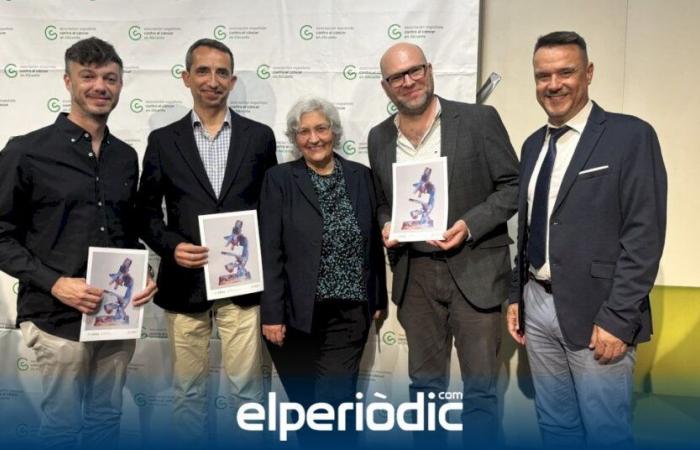With the aim of recognizing and supporting the local investigating talent, the Spanish Association against Cancer (AECC) in Alicante celebrated a day of presentation of the projects that have received AECC aids to oncological research in the province of Alicante yesterday. The event, which took place at the Elche Congress Center, had a round table in which several of the award -winnings of the Institute of Neurosciences (IN), mixed center of the Higher Council for Scientific Research (CSIC) and the Miguel Hernández de Elche University (UMH) intervened. In the event, the projects that are currently under development were presented, six aid that supposes a total of 658,535 euros.
The dialogue table promoting cancer research in Alicante was in charge of in Víctor Borrell, Khalil Kass Youssef and Mario Aguilar, who announced the main objectives of their projects and their relevance for patients. The researchers expressed their gratitude and stressed that the support of the Association will allow them to develop innovative investigations that allow transforming the results into solutions that improve the quality of life of patients.
Pediatric cancer study
The project directed by Víctor Borrell focuses on the design of therapies against ETMR, a very rare type of brain tumor that affects babies. This type of cancer is characterized by the presence of a solid and large tumor in the brain, composed of cells that are divided indefinitely causing tumor growth.
The neurogenesis and cortical expansion laboratory, led by Borrell in the IN, has developed a mutant mouse model that presents brain tumors similar to ETMR in children. “The cellular and genetic characteristics of tumors in this mouse make it a faithful model of the disease,” says the researcher. The objective of your equipment is to discover the type of cell that mutates in healthy embryos and begins to form the tumor, as well as the genes or molecules that are altered: “In this way, we can use what you learn to design new drugs that can reduce or stop the growth of these tumors in mutant mice,” explains Borrell.
Tumor invasion mechanisms
The researcher Khalil Kass Youssef is a beneficiary of two AECC projects. Thanks to the first of them, study the role that neurons play in the evolution of breast cancer towards malignancy and resistance to therapy. “The development and spread of malignant tumors depends on the interaction of cancer cells with the tumor microenvironment. These cells are capable of acting on neurons and modifying neuronal circuits close to the tumor to favor their growth and tumor invasion,” explains Youssef, which is part of the cellular plasticity laboratory in development and disease, which Angela directed in the in.
The objective of this project is the development of a new genetic monitoring technology of cell lineages in the tumor microenvironment to understand the interactions between cancer cells and the neurons of the peripheral system in a metastatic breast cancer model. “We want to understand how these interactions favor the malignancy and formation of metastasis,” says the researcher.
The second project obtained by the researcher will be developed in collaboration with the laboratory of Professor Isabel Fabregat at the Bellvitge Biomedical Research Institute (IDIBELL) in Barcelona. The team will study the tumor invasion mechanisms in bile duct cancer, known as cholangiocarcinomas. These tumors, although rare, are highly lethal and resistant to therapies, especially in stages of metastatic dissemination.
To do this, they will establish a three -dimensional model in which they will cultivate cholangiocarcinomas cells with neurons and use advanced microscopy technologies to follow the invasion and migration process on neurons. “We want to use this three -dimensional model to study the genetic and epigenetic programs that encode the invasion in order to identify new therapeutic targets and improve the treatment of patients with this type of cancer,” explains Youssef.
Queen of brain rewards
The scientist Mario Aguilar, who is part of the laboratory growth control and cancer mechanisms directed by María Domínguez, leads a project that will study the relationship between cancer cells, the brain reward system and the cells of the immune system in the animal model of the vinegar fly (Drosophila Melanogaster).
The equipment will use advanced image techniques, molecular analysis and patient databases to characterize molecular mechanisms that influence the dopaminergic system. “This project will allow us to study in depth the mechanisms after the placebo effect and the results may provide answers that allow optimizing treatments from a holistic approach,” says Aguilar.
In addition, the researcher Teresa Guillamón of the Laboratory Development, Plasticity and reprogramming of sensory circuits, directed by Guillermina López-Bendito, is leading a project to understand the effects of brain cancer in the activity of neurons and astrocytes, globally. Your equipment uses a brain metastasis model in transgenic mice and makes activity records in the different phases of the disease. The objective is to find a correlation between changes in activity and the progression of the disease and the location of the tumor, in order to use these records as a diagnosis or as a predictor of the disease.






